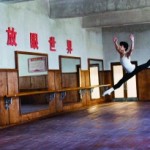Url for LaDanse Trailer on U-Tub: http://www.youtube.com/watch?v=1iU2l0XFrek&feature=player_embedded
My friend E. and I made it a point to sit in on the aisle in the last row when we went to see Frederick Wiseman’s latest film, La Danse, last night at the Brattle Theater in Cambridge–in case we needed to leave in a hurry. We’d heard it was very long (120 minutes) and that it needed some editing.
But we ended up staying through to the end–partly because we wanted to take part in the question and answer session with Wiseman, but mainly because, despite the film’s length and some imperfections, we found it quite beautiful.
It’s cinema verite, shot by Wiseman with a handheld 16MM camera, of practice, dress rehearsals, and behind the scenes discussions at the Paris Opera Ballet, over 13 weeks in Paris in 2007.
I was fascinated by the sessions in which choreographers and coaches viewed and critiqued dancers such as Nicolas Le Riche, Marie-Agnès Gillot, and Agnès Letestu, among others. In those scenes, Weisman provides the rare opportunity to understand what emotions the dancers are asked to convey and how they do it; the detailed movements that go into that; and the occasional difficulty some dancers have in translating direction into specific action.
A photographer myself, I enjoyed the interspersing of arty still views of stairwells, window casings but, because some outside shots of Paris and the Opera House seemed to repeat, I wondered if Wiseman had come away with too little covering footage.
It was also great to see some of what happens behind the scenes: the painstaking sewing of sequins into costumes, one by one; the serving of apparently overcooked broccoli and fish with sauce in the cafeteria; the cleaning of the performance hall, and, especially, meetings of administrators discussing their fundraising efforts–which, combined, give some sense of what’s involved in producing some 250 performances a year.
Wiseman did a wonderful job of filming rehearsals for seven ballets: Genus by Wayne McGregor, Le Songe de Mede by Angelin Preljocaj, La Maison de Bernarda by Mats Ek, Paquita by Pierre Lacotte, Casse Noisette by Rudolph Noureev, Orphe and Eurydice by Pina Bausch, and Romeo and Juliette by Sasha Waltz. Some of the more modern pieces seemed to go on and on but most were mesmerizing–and unlike any I’ve seen in the US.
Wiseman could, perhaps, have left out a few–and, because it’s hard to stare at a screen for three hours straight, I’d have appreciated an intermission. (And, no doubt, so would those who got up to go to the rest room in the middle, blocking our view of the screen).
I found Wiseman’s fly-on-the-wall technique a bit disturbing–mainly because it showed almost no verbal interaction among the dancers, who were portrayed as objects to be molded and by teachers and administrators. But perhaps that’s how it is in the dance world and in the company, described by artistic director, in one segment, as “hierarchical.”
In the Q&A, Wiseman seemed reluctant to answer questions about content or meaning. (When someone asked why he’d included a scene involving beehives on the roof of the opera house, he said that’s for the viewer to figure out–perhaps, I thought, because it’s too obvious a metaphor).
Nor was Wiseman forthcoming about his thought processes (or lack, thereof) in structuring or editing the film. He spent a day looking around the building, then started shooting, he said. After 13 days, he returned with 130 hours of film; spent a year reviewing, culling, editing, reviewing, adding, cutting–and here we were.
It seemed to me that the film could use more structure and that some scenes were repetitive–but given the beauty and grace of the dancers, I’m hard-put to say which sequences I’d leave out.
—–Anita M. Harris
New Cambridge Observer is a publication of the Harris Communications Group of Cambridge, MA. We also publish HarrisComBlog and Ithaca Diaries Blog.
 OK, I guess it’s time for me to weigh in on Sunday’s Oscar ceremonies. My friends R, A and I could not help but notice that many of the be-gowned stars had bad hair: it was either stringy, in their faces or matted down, in patches. Watching from anything-goes Cambridge, even we were shocked. We liked Jennifer Hudson’s red dress and new figure and Oprah’s hair and straightforward presence (if not the boxiness of created by the stiching in her black bodice). We were a bit creeped out by Kirk Douglas and relieved when he made it through. I thought Anne Hathaway was great in Love and Other Drugs, did a great job with her song, and was a clear winner in the best gushiness category.
OK, I guess it’s time for me to weigh in on Sunday’s Oscar ceremonies. My friends R, A and I could not help but notice that many of the be-gowned stars had bad hair: it was either stringy, in their faces or matted down, in patches. Watching from anything-goes Cambridge, even we were shocked. We liked Jennifer Hudson’s red dress and new figure and Oprah’s hair and straightforward presence (if not the boxiness of created by the stiching in her black bodice). We were a bit creeped out by Kirk Douglas and relieved when he made it through. I thought Anne Hathaway was great in Love and Other Drugs, did a great job with her song, and was a clear winner in the best gushiness category.

